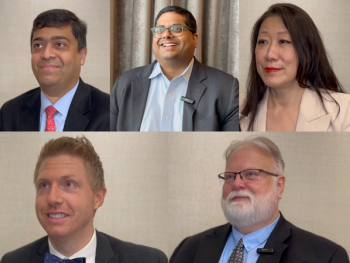
Site of Service and the Challenge of Value-Based Care
Andrew L. Pecora, MD, CPE: From your perspective, when looking at the oncology spending, everybody puts that same slide up and shows what you spend on surgery, the medicines, the hospital admissions, the emergency room visits, etc. But, I’d like you to go 1 layer deeper. I don’t think anyone argues the fact that it’s less expensive to treat cancer patients in the community setting and a private practice office versus a large hospital setting, even if it’s an outpatient hospital setting. It’s not a subtle difference. But, yet, everything, at least right now, has been aligned to be adverse to that model. That’s why more and more cancer doctors are giving up their practices and just signing up to be employed.
Now, there might be a greater strategy there where you can reduce variance because there are fewer providers, because they’re aggregating. But as you think about this question, what do you think about this issue of site of service? Not just an individual service type, but site of service?
Brenton Fargnoli, MD: So, I think what you’re alluding to is the 340B and other policies that make it more economically feasible to provide hospital-based versus community-based oncology care. We have seen a tremendous shift in community oncology. In 2004, 80% to 90% of care was provided in the community setting, and now it’s about 50/50, largely due to a lot of these policies. I think, as we go toward value-based care, it’s going to be a really important point in terms of where that totality of care can happen. And I think there are arguments for both sides.
Large hospitals can have robust IT infrastructures, have connected specialists and subspecialists throughout, and have a view into that. And alternatively, smaller practices are lean. They don’t have as much bureaucracy. They can change their clinical processes on a dime and can, therefore, iterate a lot faster. We’ve seen that in some of the 2014 ECO data. It will be interesting to see, as these 2 separate entities both shift to value-based care, how they’re able to evolve. But, certainly, site of service has had an impact on the landscape of where oncology is being delivered today.
Andrew L. Pecora, MD, CPE: What do you think? I’ve actually witnessed it. There’s a literal schizophrenia about the messaging from government. Now, this is the CMS (Centers for Medicare & Medicaid Services). I know the people, and they really want to do the right thing. On the one hand, they want to incentivize patients to go to a site where quality is there, but also where it’s the least expensive site of service. But, on the other hand, the same group of individuals are putting out policies where you’re cutting the revenue and the margin on drug, and that’s, in fact, how oncologists make their living and support the oncology nurses, including all the other added expenses and inventory for the incredibly expensive drugs. So, what are your thoughts about that schizophrenia?
Rena M. Conti, PhD: I agree that policy, particularly among the government payers, has been a little schizophrenic. I think, on one hand, there is this general understanding that “bigger is better” because we get scale. With scale comes economies of production, and that should be true for all areas of medicine, just like it is for other aspects of the bucket. On the other hand, the more that we consolidate, the more power providers have when negotiating to set rates, or help set rates, with commercial insurers and drive patients to certain types of care settings where the bills can be, for exactly the same type of care, double depending on the setting.
We’ve seen a number of studies that have shown that—particularly for drug-based cancer care. So, site-of-care concerns are an issue. They’re real. At the same time, I would argue it’s really good and healthy for cancer care and for patients to have a choice of where they get their care provided. It’s good for families to be able to choose where they’re going to be able to get their care, because there’s transportation costs and other types of costs associated with caring for one’s loved one when they have cancer, that make it important for families to be able to choose. And with choice, brings competition. It brings quality.
We’re kind of struggling with those 2 sides of the market, if you will. I do think that there will be more consolidation coming as we transition to more incentives for reducing the cost of certain types of care or for managing the cost of certain types of care. Smaller practices are just simply not going to be able to take that risk. They’re going to have to invest in things that they just don’t have the money or the access to capital to do. But, I also think the really strong incentives to drive patients into the hospital outpatient department are going to change dramatically once we have site-of-care service payments that normalize between the community and the hospital.
The Medicare Payment Advisory Commission (MedPac), which is the advisory committee for the Medicare program, has already recommended a 43% reduction in facility fees. That will dramatically change the incentives for patients being seen in a hospital setting as opposed to those being seen in a community setting.
Andrew L. Pecora, MD, CPE: Now, let’s jump back over to Dr. Sagar and get her take.
Bhuvana Sagar, MD: So, the question was, are there any challenges in working with community oncologists versus hospital-based providers in this value-based world? We have actually worked with both community-based oncologists and facility-based groups. We have not seen a major change in how doctors approach this whole problem. The challenges may come in the infrastructure cost, but we’ve noticed that even hospitals find that this is a huge investment that they have to make—from electronic health records technology to hiring somebody to look at their cost data and claims data to understand where they’re not doing as well as someone else does compared to a national benchmark, for example.
So, the cost, or the investment, is pretty steep, I think, for hospitals as well. I don’t think it can be downplayed. But overall, we’ve noticed that community oncologists are a little bit more open to the approach at this point.
We’ve been pleasantly surprised with a lot of facility-based practices as well. We’ve talked to several hospital-based groups. We have a couple of hospitals in our model as well, and they do have navigators in place. They do have some very good survivorship programs in place that our model encourages, and they’ve done really well so far. But, all of these relationships are fairly new. So, like I said earlier, it’s a test-and-learn process at this point. As we go along, we’ll understand the opportunity a little bit better.
Newsletter
Stay ahead of policy, cost, and value—subscribe to AJMC for expert insights at the intersection of clinical care and health economics.















































